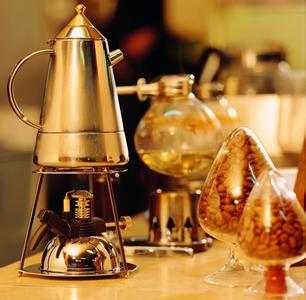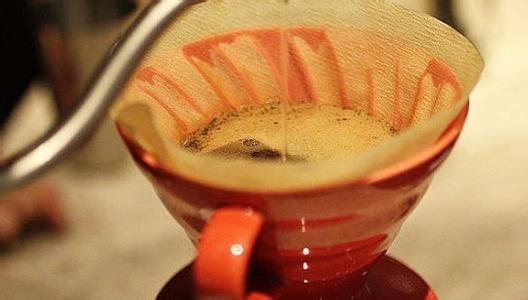The principle of mocha pot and matters needing attention in correct use

1. Water level: use warm water and the water level is 0.5 cm below the safety valve. The safety valve will automatically relieve pressure when the lower pot pressure is too high, in order to prevent safety accidents. If the water level is higher than the safety valve, the function of the safety valve can not play normally.
2. Coffee powder: coffee powder is medium-fine-grained and filled with powder trough. when filling the powder, vibrate the powder trough properly so that the coffee powder is evenly distributed. after filling it, gently press the surface with your fingers to make the powder denser.
Process analysis:
1. Initial heat: after the kettle is heated, the air part expands by heat, resulting in pressure, and the water reaches the powder trough through the aqueduct. After soaking in water, the coffee powder expands rapidly to form pressed powder. At this time, the water in the lower pot is resisted by pressed powder, and the closed pressure in the lower pot continues to increase.
The purpose of the first heat is to raise the water level to the position of the powder trough and let the coffee powder form cakes, so there is no need for high pressure and high temperature, as long as the heat is low. If you open the lid of the upper pot to observe, a small amount of coffee will flow out, and then the coffee will no longer flow out.
2. Pressurization: after the coffee cakes in the powder trough, the pressure in the lower pot begins to increase, turn the fire to medium heat, and let the pressure continue to increase.
3. Extraction: fire. The pressure of the lower pot is increased to balance with the resistance of the coffee pressed powder, turn on the fire, and let the pressure exceed the critical point of this balance. Under the action of the continuous fire, let the water quickly pass through the coffee pressed powder to get the coffee liquid with complete extraction and balanced taste.
4. Raise the pot: turn off the fire. Turn off the fire as soon as there is a steam purr in the upper pot of coffee. Then let the coffee pot stand for about 30 seconds.
There is a proper distance between the aqueduct of the lower pot and the base of the lower pot, and if you continue to heat, there is still hot water passing through the powder trough, and the extracted coffee has a residual smell of coffee; in addition, if you shake the lower pot, the pressure of the lower pot will increase intermittently, or because the water level of the lower pot is not balanced, there is still water passing through the powder trough. Both reasons cause coffee to be overextracted or overheated.
5. Taste: remove the coffee pot from the stove. At this time, it is still necessary to rest the coffee pot for about 30 seconds to 1 minute. Because the coffee extraction process goes through three different stages, it needs to be re-homogenized in the static process. After the taste of coffee will no longer have the phenomenon of uneven ups and downs, very soft.
View of operation effect:
After pouring out the coffee liquid, wait for the coffee pot to cool (or rinse the pot with cold water to cool), unscrew the upper pot and observe the pressed powder in the powder trough. At this point, the pressed powder should be completely cake-shaped, without collapses and voids. If there are collapses and voids, the effect of coffee extraction will not be good. Press with your fingers, it should be dense and slightly elastic.
Important Notice :
前街咖啡 FrontStreet Coffee has moved to new addredd:
FrontStreet Coffee Address: 315,Donghua East Road,GuangZhou
Tel:020 38364473
- Prev

Tips for using an electric coffee maker skills for using a household coffee maker
There are many kinds of electric coffee pots, so the methods of use are not the same. When in use, it should be used in accordance with the requirements of the product instructions, and generally can be operated according to the following steps: 1. Adding water: each electric coffee pot requires a rated amount of water, which includes the amount of water absorbed by evaporation and coffee powder. Therefore, when in use, it should be specified to add water, neither excessive nor excessive.
- Next

Folding method of basic common sense filter paper for hand-brewed coffee
Follicle Coffee: the folding of filter paper We are using follicle coffee these days, just a little bit of detail to explain the various links. Today, let's take a look at the folding of filter paper. It's not complicated, just look at my diagram.
Related
- What is the meaning of lactic acid fermentation with coffee bean treatment?
- How to judge the state of foam by sound?
- How does the latte pull out the unicorn pattern? Come to get for a little trick to improve the flower pull!
- Will flower pulling affect the taste of the latte?
- Do you know the history of coffee?
- The difference between honey treatment and sun washing what is raisin honey treatment?
- What kind of milk can a novice use to make coffee foam to keep the foam longer? The correct method and skills of milking tutorial sharing
- Why do washed coffee beans taste sour? Flavor characteristics of washed Coffee
- Introduction to the skill of how to practice the size and height of water injection around the circle of hand-brewed coffee
- How do beginners practice coffee flower drawing from scratch?

